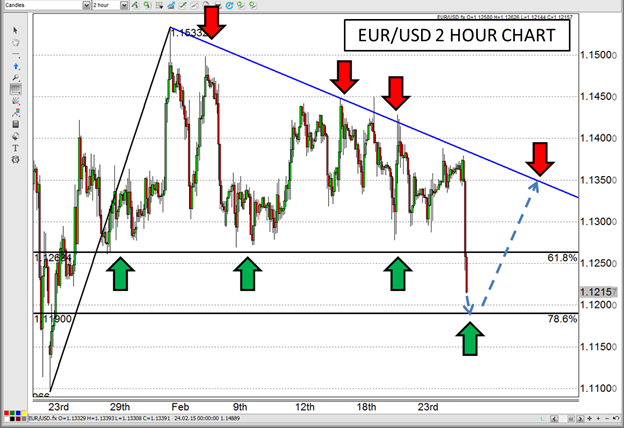![]()
The early portion of the North American trading session has been quite exhilarating thus far with a bevy of inflationary indicators suggesting that our worst fears aren’t a reality in both the US and Canada. Core Consumer Price Indexes in both nations were better than anticipated which gave both the USD and the CAD a boost against all of the other major currencies; none more so than the EUR/USD which FINALLY broke through major support near 1.1260. Along with the encouraging inflation figures for the US were Durable Goods Orders that surged 2.8% and the Housing Price Index that grew 0.8%. However, not all was rainbows and puppy dogs as both of the employment indicators, Initial Jobless Claims and Continuing Jobless Claims, were worse than anticipated.
Circling back to the EUR/USD, the range that it broke out of was one that it had been mired in for a bulk of the last month. Through all the European strife related to Greece and the eventual aftermath the currency pair was stuck in about a 250 pip range that was finally taken out to the bottom side after the data releases. It’s almost like a sigh of relief for investors now that they feel they can sell the euro without having to worry about stubborn support holding it up anymore. However, that sigh could backfire if the next level of support holds as a short squeeze could take hold.
Going back to the 2015 low to the February high, the EUR/USD found support at the 61.8% Fibonacci retracement (1.1260) and held there, however, the 78.6% Fibonacci retracement looms just below 1.12, and could be the next frustrating support that doesn’t want to yield. Considering the overall angst felt toward the euro in general, that 78.6% Fibonacci level may very well be the staging point for a rally that could squeeze out many of the bandwagon euro sellers as they pile in to the short side of the troubled currency.
The information and opinions in this report are for general information use only and are not intended as an offer or solicitation with respect to the purchase of sale of any currency. All opinions and information contained in this report are subject to change without notice. This report has been prepared without regard to the specific investment objectives, financial situation and needs of any particular recipient. While the information contained herein was obtained from sources believed to be reliable, author does not guarantee its accuracy or completeness, nor does author assume any liability for any direct, indirect or consequential loss that may result from the reliance by any person upon any such information or opinions.
Recommended Content
Editors’ Picks
AUD/USD could extend the recovery to 0.6500 and above

The enhanced risk appetite and the weakening of the Greenback enabled AUD/USD to build on the promising start to the week and trade closer to the key barrier at 0.6500 the figure ahead of key inflation figures in Australia.
EUR/USD now refocuses on the 200-day SMA

EUR/USD extended its positive momentum and rose above the 1.0700 yardstick, driven by the intense PMI-led retracement in the US Dollar as well as a prevailing risk-friendly environment in the FX universe.
Gold struggles around $2,325 despite broad US Dollar’s weakness

Gold reversed its direction and rose to the $2,320 area, erasing a large portion of its daily losses in the process. The benchmark 10-year US Treasury bond yield stays in the red below 4.6% following the weak US PMI data and supports XAU/USD.
Bitcoin price makes run for previous cycle highs as Morgan Stanley pushes BTC ETF exposure

Bitcoin (BTC) price strength continues to grow, three days after the fourth halving. Optimism continues to abound in the market as Bitcoiners envision a reclamation of previous cycle highs.
US versus the Eurozone: Inflation divergence causes monetary desynchronization

Historically there is a very close correlation between changes in US Treasury yields and German Bund yields. This is relevant at the current juncture, considering that the recent hawkish twist in the tone of the Federal Reserve might continue to push US long-term interest rates higher and put upward pressure on bond yields in the Eurozone.
